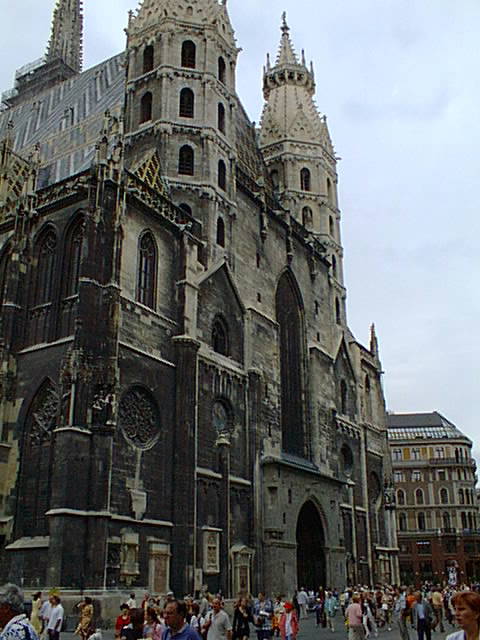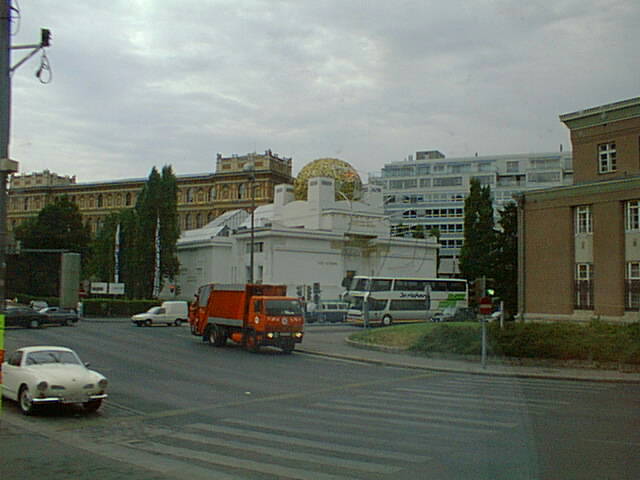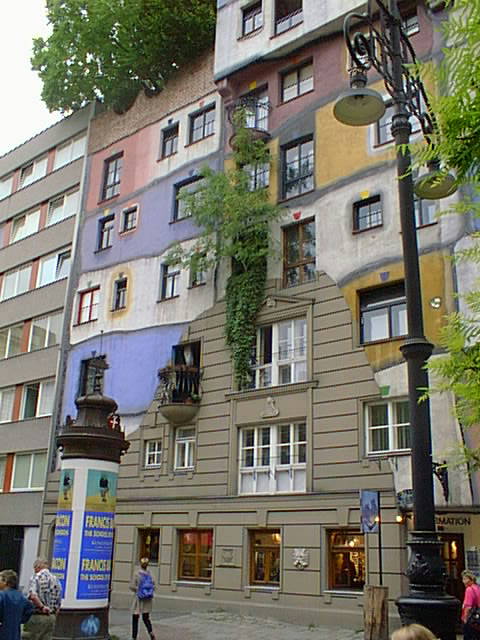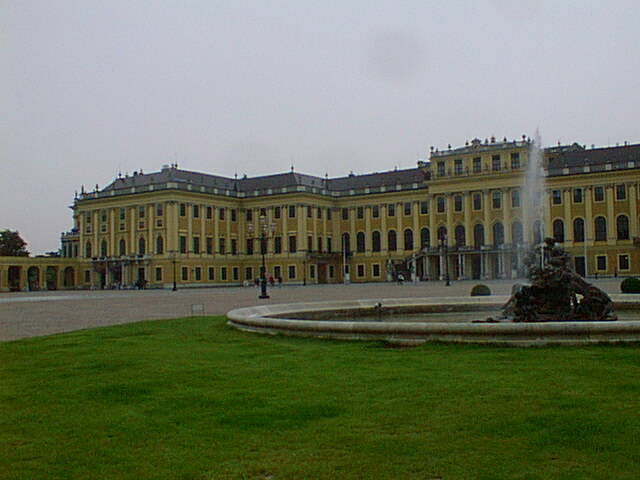
I mentioned on yesterday's page that we expected Vienna to be cooler than Italy, and it was--a lot. In fact, it had begun to cool significantly in Venice by the time we left; between dinner and when we departed for the train station, several of us were just standing on the bridge over the Grand Canal near our hotel, enjoying the cool breeze and the boats going past. Then we got on the overnight train, slept as much as we were able (some people deal with that kind of an environment better than others!), and got out this morning into rainy, cool weather in Vienna. Being one who likes it warm, I was obliged to break my tweed coat out of storage!

We began the day in Vienna with a three-hour guided sightseeing tour around the "gürtel", or belt, of roads around the old city, and down to the center of the city, which is the 12th-century cathedral of St. Stephan. Among other interesting feature of the building, set into a wall to the left of the main entrance were "standards" against which the wares of medieval merchants could be checked if they were accused of shorting the customers. There was a circle for a loaf of bread, and two iron rods for standard lengths of linen or wool; the rod for linen was longer because that fabric was supposed to be sold in lengths that accounted for the fact that it would shrink when washed! The stained-glass windows behind the main altar had been protected with sandbags during the battle for control of Vienna at the end of WWII, so they had survived the bombardment intact as far as I could see.

The overall impression I got of the city was that the Viennese take their architecture seriously! There were many examples of the "historical style", inspired by the forms of the distant past, which rather abruptly fell out of fashion about a century ago and was replaced by a less ornate style. The photo above (shot through the bus window) shows the Secession, the headquarters and (I suppose one might call it) the manifesto of a group of artists who seceded from the local professional body, the Association of Artists, over the merits of different architectural styles in 1898. We could also see plenty of utilitarian, almost unornamented housing projects (Wohnhäuser) built by the city to solve a housing crunch from 1920-1934 and after WWII. Then there were the buildings that were designed to look older than they were, like the Parliament, which is in the style of ancient Greece, and relatively recent churches built to look Gothic.

Then there was this building, created in reaction against the bland, unnatural symmetry that the architect, Friedensreich Hundertwasser, perceived in such recent public buildings; this apartment complex has trees and greenery incorporated into its structure, and a riot of contrasting colors and textures. Our guide, Susanne, told us that when this building is shown by guides leading groups of Italian tourists, they refer to it as "The Crazy House" rather than "Hundertwasser House"...
Sorry I don't have more pictures from the morning tour; the rain on the windows, not to mention the occasionally narrow streets and intervening trees, made it difficult to get decent pictures of the many monumental structures along the gürtel roads and towards the city center. Only the shot of the Secession (seen above) came out halfway decent of the ones I took from inside the bus.
After the bus tour, we went to our hotel and checked in; most of us immediately grabbed the opportunity to take a much-needed shower and/or nap, even before going to get lunch. We had the afternoon (about 2 p.m. to 6 p.m.) to go around Vienna on our own before gathering for dinner; several of us decided to get on the U-Bahn (subway) and go to the Schönbrunn Palace.

This is the imperial residence of the Habsburg (or Hapsburg) family, who ruled the Austro-Hungarian Empire until the end of WWI. It started out as a hunting lodge, and was reworked in full-throttle rococo style to become a residence at the direction of Maria Theresa. The name means "beautiful fountain" or "beautiful spring"; the story is that the Emperor Matthias, one of the early Habsburg rulers, got lost on a hunting expedition in the dense woods that occupied the site at the time, and was about to die of thirst when he happened on a beautiful spring of clear water. By the time Maria Theresa (and later rulers, who added to it and redecorated existing areas) got through with it, there were 1441 rooms in the palace! There is also a vast garden out back, crowned by the "Gloriette", a (relatively) light, open structure that is nevertheless almost as big as the main building of the palace; and there is a zoo, which a poster I saw calls the oldest in the world (founded in 1752). Unfortunately, I didn't have time to visit the gardens or the zoo before they closed.

However, I did get over to the carriage house,which displayed everything from sedan chairs to sleighs to the eight-horse imperial carriage. This is thought to have been built in 1763, and was used on state occasions like coronations; the last use was in 1916, when Emperor Karl was crowned the Apostolic King of Hungary.
After we had dinner at the Gösser Bräu restaurant, a large fraction of the group went off to a concert of the music of Mozart. There are, of course, a lot of musical monuments and a lot of musical history in this town; on our bus tour, we saw the monument to the Waltz King, Johann Strauss, and the theater where Beethoven's "Fidelio" premiered, as well as one of several places that Mozart lived in the city. I hope to look into that aspect a little more before we head out Saturday; we'll have limited opportunities, though, as we spend all of tomorrow in Bratislava, Slovakia, and the next morning we go out to the Wiener Wald (Vienna Woods). Well, there will be plenty to see there too, I'm sure!
 To
Thursday, 8 July 1999
To
Thursday, 8 July 1999 Back
to choir tour itinerary
Back
to choir tour itinerary Back
to choir tour home page
Back
to choir tour home pagenew 7 July 1999, updated 13 July 1999